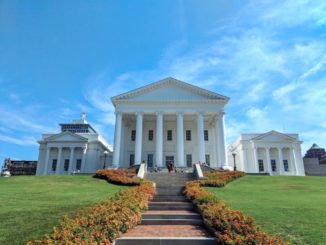
~ Press release issued by Virginia Farm Bureau Federation
EASTVILLE — Virginia’s farmland acreage has decreased considerably over the past several decades, yet farmers continually find ways to improve production.
According to research conducted by the Virginia Tech College of Agriculture and Life Sciences, farmed acreage in Virginia dropped 50 percent from 1949 to 2016, while farming output increased by 33 percent.
Kyle Sturgis, a Northampton County row crop, vegetable and aquaculture producer, credited the added production to advancements in land management practices and expanded crop variety selections, specifically those developed through Agency 229 research.
“The assistance we get from agency research is phenomenal,” Sturgis said. “They’re looking at variety trials and are telling us which crop varieties did best during their research; that way we can pick the right crops that will produce higher yields on those smaller plots of land and feed a growing population.”
Agency 229 provides funding to Virginia Cooperative Extension and the Virginia Agricultural Experiment Station. Through these entities, the agency supports scientists and other specialists who conduct innovative agricultural research at the VAES and its 11 Agricultural Research Extension Centers. Data collected from that research is disseminated to Extension agents, who then share the information with farmers and agricultural businesses.
Throughout the 2021 Virginia General Assembly, Virginia Farm Bureau Federation has advocated for increased Agency 229 funding through a state budget amendment. The proposal has gained bipartisan support from Del. David L. Bulova, D-Fairfax, and Sen. Emmett W. Hanger Jr., R-Mount Solon.
The proposed amendment would allocate $1.92 million to Agency 229 to improve research equipment and internet connectivity across agency offices, as well as provide added funding to Extension for agent recruitment and retention.
Additional studies from Virginia Tech indicate for every dollar Virginia invests into Agency 229 programs, the return on investment is $1.29. Data collected from 1949 to 2016 also revealed state spending on Extension netted a 42.4-percent return on investment, while expenditures on agricultural research earned a 26.4-percent return.
Overall, investments in research and Extension throughout the 67-year period produced a 19-percent increase in agricultural productivity.
Jay Hundley, an Essex County grain producer, said Extension helped boost his farm’s productivity in the early ‘90s, when a cyst nematode issue was hindering his soybean crop.
“We could barely grow any beans, so we did a lot of work with our local Extension agent to get it figured out,” said Hundley, who also serves as Essex County Farm Bureau president.
“In the end, their research and testing helped us find something that would grow and save us money. And, of course, finding those high-yield varieties helped our bottom line tremendously.”
Hundley noted research conducted at Extension offices and ARECs across Virginia is critical because it allows farmers to see non-biased results of plot work done in their respective areas.
Without adequate funding, he said, Extension would have fewer resources and personnel to provide the volume and quality of agricultural research Virginia farmers rely on.
“This research is the reason farmers are able to be more efficient in growing crops and be more environmentally sound using fewer chemicals,” Hundley said. “We need to be sure that we continue to find the funding to keep this work going.”
•••
RELATED ARTICLES
Agriculture groups urge vaccination priority for farm and food workers



Be the first to comment